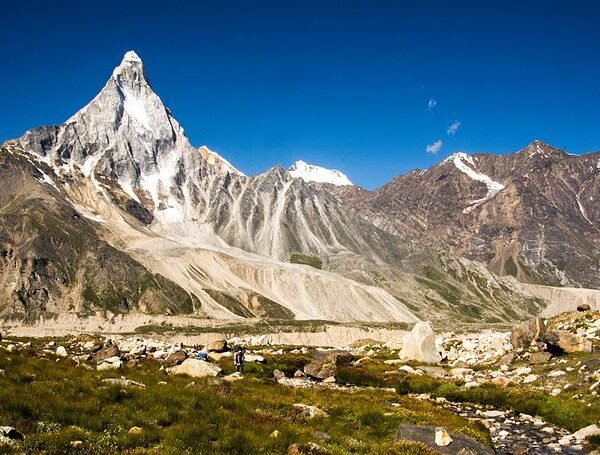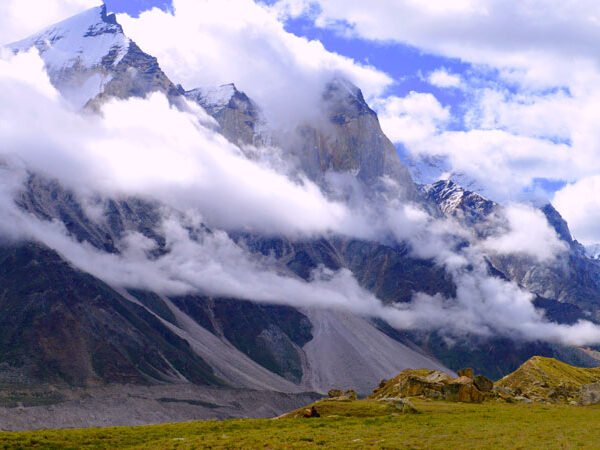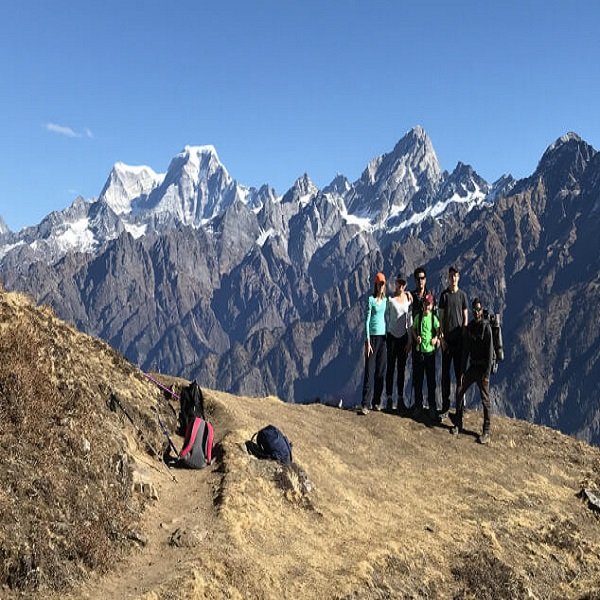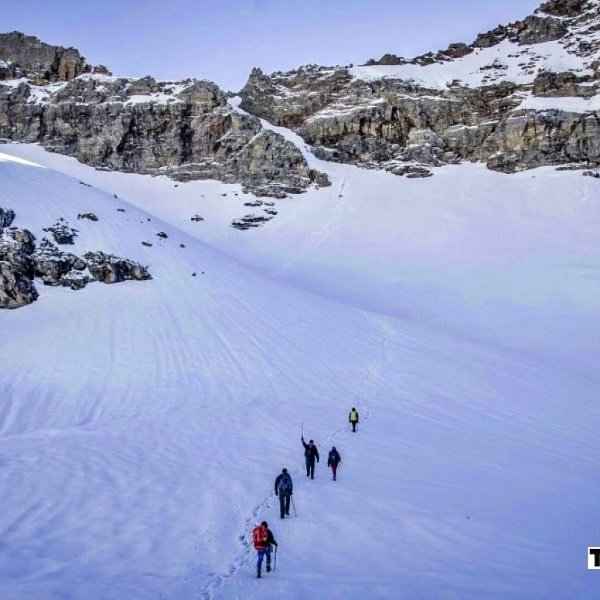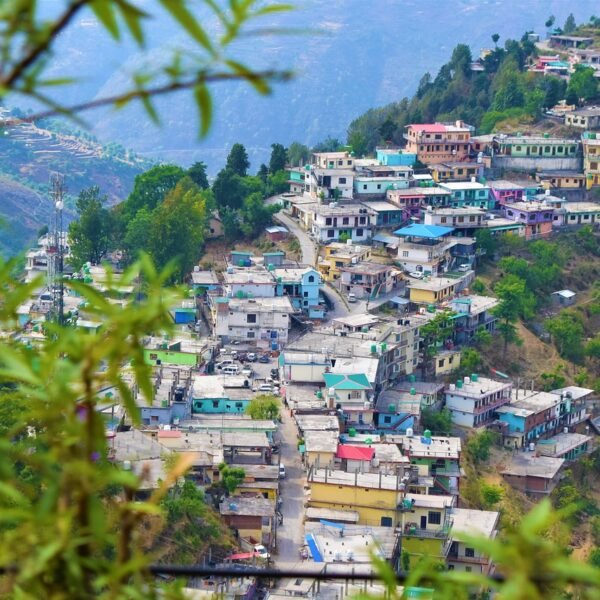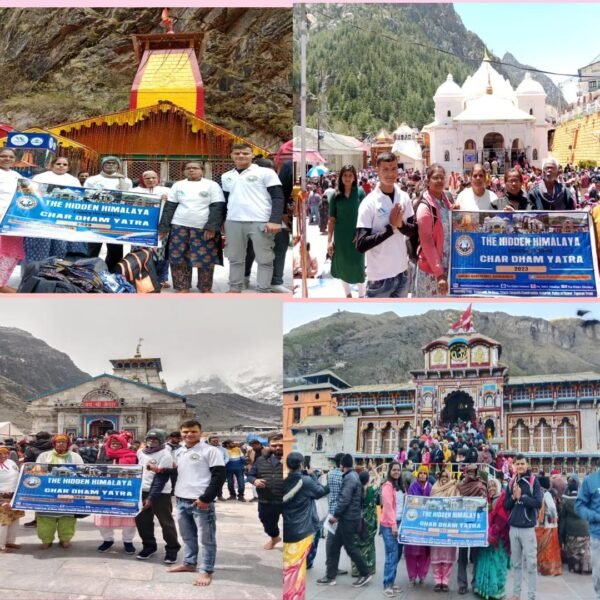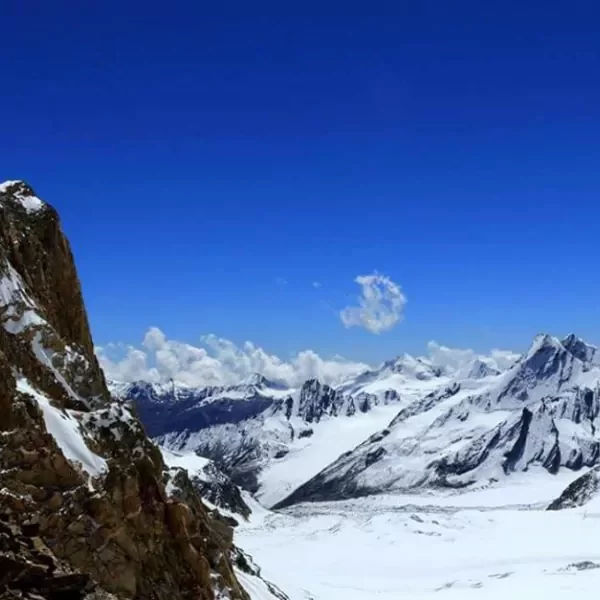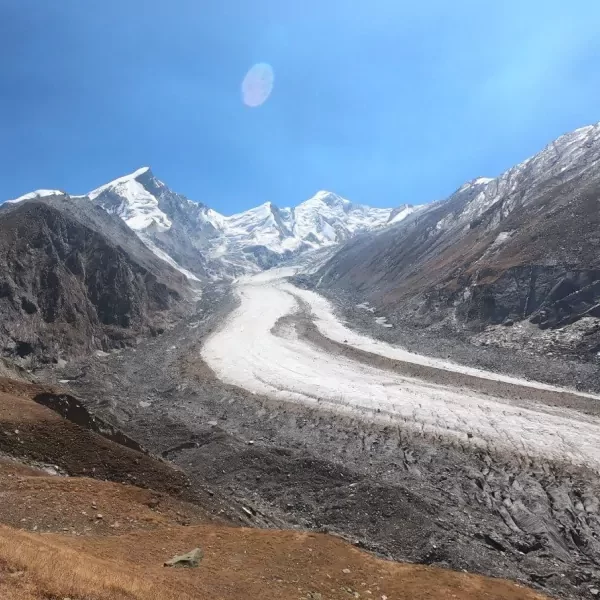Gaumukh Tapovan Trek
Overview
Gaumukh Tapovan Trek
Gaumukh Tapovan Trek is a renowned trekking expedition in the Garhwal Himalayas of Uttarakhand, India, offering breathtaking views of towering peaks, glaciers, and serene alpine meadows. The trek starts from Gangotri, the origin of the sacred river Ganges, and proceeds along the banks of the Bhagirathi River. Trekkers pass through dense forests, rocky terrain, and picturesque landscapes en route to Gaumukh, the snout of the Gangotri Glacier, where the river emerges. The trail continues to Tapovan, a high-altitude meadow surrounded by towering peaks including Shivling, Bhagirathi Parbat, and Meru. At Tapovan, trekkers are rewarded with panoramic views of the Himalayan ranges and the opportunity to witness the confluence of several glaciers. The Gaumukh Tapovan Trek is renowned for its spiritual significance, stunning vistas, and challenging yet gratifying terrain, making it a must-do for trekking enthusiasts.
History of Gaumukh Tapovan Trek
history of the Gaumukh Tapovan Trek is intertwined with the rich cultural and religious heritage of the region. The trek derives its significance from the sacred river Ganges, which is believed to originate from the Gaumukh Glacier, located at the snout of the Gangotri Glacier.
The trek route has been traversed by pilgrims and sadhus (holy men) for centuries as part of their spiritual journey to Gangotri, one of the Char Dham pilgrimage sites in Hinduism. Tapovan, a high-altitude meadow en route to Gaumukh, holds immense religious importance as it is believed to be the meditation site of ancient sages and saints.
Over the years, the Gaumukh Tapovan Trek has gained popularity among adventure seekers and nature enthusiasts due to its stunning Himalayan landscapes and unique cultural experiences. Today, the trek continues to attract pilgrims, trekkers, and spiritual seekers alike, contributing to its historical and cultural significance in the region.
Mountain ranges visible from Gaumukh Tapovan
Gaumukh Tapovan, trekkers are treated to awe-inspiring views of several prominent mountain ranges in the Garhwal Himalayas of Uttarakhand, India. Some of the notable mountain ranges visible from Gaumukh Tapovan include:
- Bhagirathi Group: The majestic Bhagirathi peaks dominate the skyline, with Bhagirathi I, II, and III standing prominently. These peaks are revered by locals and hold significant religious importance in Hindu mythology.
- Shivling Peak: Towering over the surrounding landscape, Shivling Peak is one of the most iconic and sacred peaks in the region. Its distinctive shape and spiritual significance make it a highlight of the trek.
- Meru Parbat: Also known as Meru Peak, this imposing mountain stands tall in the distance, adding to the breathtaking panorama visible from Gaumukh Tapovan.
- Thalay Sagar: Another prominent peak in the vicinity, Thalay Sagar is renowned for its challenging climbing routes and stunning alpine scenery.
- Sudarshan Parbat: This striking mountain range completes the panoramic vista, offering trekkers a glimpse of its rugged beauty against the backdrop of the Himalayan skyline.
Why you must go for Gaumukh Tapovan Trek?
Gaumukh Tapovan Trek is a captivating expedition that offers a blend of spiritual significance, stunning natural beauty, and thrilling adventure. Here are several compelling reasons why you should embark on this remarkable trek:
- Spiritual Journey: The trek begins at Gangotri, the origin of the sacred river Ganges, and leads to Gaumukh, the snout of the Gangotri Glacier. This pilgrimage route holds immense religious importance for Hindus, providing a chance to witness the divine source of the holy river.
- Scenic Landscapes: Along the trail, trekkers are treated to breathtaking views of towering peaks, pristine glaciers, lush alpine meadows, and gushing mountain streams. The diverse terrain offers a visual feast of natural beauty at every turn.
- Himalayan Panorama: From Gaumukh Tapovan, trekkers are rewarded with panoramic vistas of prominent Himalayan peaks, including the majestic Bhagirathi Group, Shivling Peak, and Meru Parbat, creating an unforgettable backdrop for the trek.
- Adventure Thrills: The trek presents a moderate to challenging terrain with steep ascents, rocky trails, and river crossings, offering adventure enthusiasts an exhilarating experience amidst the rugged Himalayan landscape.
- Cultural Encounters: Trekking through remote villages and interacting with local communities provides an opportunity to immerse yourself in the rich culture and traditions of the Garhwal region, offering insights into the way of life in the Himalayas.
- Personal Growth: The Gaumukh Tapovan Trek challenges your physical endurance and mental resilience, offering a transformative journey that fosters personal growth, self-discovery, and a deep connection with nature.
The best part of History Gaumukh or Topvan Trek
The most captivating aspect of the history of the Gaumukh Tapovan Trek lies in its deep-rooted spiritual significance and ancient cultural heritage. According to Hindu mythology, Gaumukh, the snout of the Gangotri Glacier, is believed to be the origin of the sacred river Ganges, where Lord Shiva released the river from his locks of hair. This mythological tale adds a mystical aura to the trek, drawing pilgrims and spiritual seekers to witness the divine source of the holy river. Additionally, Tapovan, a high-altitude meadow en route to Gaumukh, holds immense significance as a meditation site for ancient sages and saints. It is said that several revered saints, including Sage Narada, Sage Vyasa, and Guru Gorakhnath, meditated in the serene environs of Tapovan, infusing the landscape with spiritual vibrations and profound wisdom. The blend of myth, legend, and spirituality associated with the trek's history adds depth and intrigue to the journey, making it a profound and transformative experience for trekkers.
Why should Tapovan trek?
Tapovan trek offers a transformative journey that combines spiritual exploration, breathtaking natural beauty, and exhilarating adventure, making it an experience of a lifetime. Here are several compelling reasons why you should embark on the Tapovan trek:
- Spiritual Significance: Tapovan is revered as a sacred place where ancient sages and saints, including Sage Narada and Guru Gorakhnath, meditated. The tranquil surroundings and spiritual vibrations of Tapovan offer a unique opportunity for introspection and inner peace.
- Himalayan Panorama: The trek provides panoramic views of majestic Himalayan peaks, including Shivling, Meru Parbat, and Bhagirathi, creating an awe-inspiring backdrop for the journey.
- Pristine Environment: Tapovan is nestled amidst pristine alpine meadows, glistening glaciers, and cascading waterfalls, offering a serene environment for trekkers to reconnect with nature.
- Adventure Thrills: The trek presents moderate to challenging terrain with steep ascents, rocky trails, and river crossings, providing adventure enthusiasts with an exhilarating and rewarding experience.
- Cultural Immersion: Trekking through remote villages and interacting with local communities offers a glimpse into the rich culture and traditions of the Himalayan region, enriching the overall trekking experience.
Tapovan trek in April to June ?
The period from April to June is an optimal time to embark on the Tapovan trek, offering favorable weather conditions and stunning natural landscapes. During these months, the weather in the Himalayas is generally pleasant, with mild temperatures during the day and cool nights, providing comfortable trekking conditions. As the snow from the winter season begins to melt, the trekking trails become more accessible, allowing trekkers to navigate the route with ease. Moreover, the spring season brings the Himalayan flora to life, with colorful flowers blooming across the meadows, creating a picturesque backdrop for the trek. Additionally, wildlife sightings are common during this time, adding to the overall trekking experience. While April to June is a popular time for trekking in the Himalayas and may see moderate foot traffic, the breathtaking beauty and favorable weather make it an ideal period for undertaking the Tapovan trek.
Tapovan trek in September or October
Tapovan trek in September or October offers a unique and enchanting experience amidst the stunning landscapes of the Himalayas. During these months, the weather in the region begins to transition from the monsoon season to autumn, creating favorable trekking conditions. The days are typically sunny and pleasant, with clear skies providing breathtaking views of the surrounding peaks. As the monsoon rains subside, the trekking trails become more stable, making it easier for trekkers to navigate the route. September and October also mark the onset of autumn, resulting in a vibrant display of colors as the foliage changes hues, adding to the scenic beauty of the trek. Moreover, wildlife sightings are common during this time, offering trekkers the opportunity to spot a diverse range of Himalayan flora and fauna. Overall, September and October provide an ideal window to embark on the Tapovan trek, offering a perfect blend of favorable weather, stunning landscapes, and unique natural beauty.
Altitude we are going to cover in Tapovan Trek
Tapovan Trek encompasses varying altitudes throughout the journey. It typically begins at Gangotri, located at an altitude of approximately 3,100 meters (10,170 feet) above sea level. From Gangotri, trekkers ascend to higher elevations as they progress along the route towards Tapovan. The highest point of the trek is reached at Tapovan itself, which sits at an altitude of around 4,463 meters (14,640 feet) above sea level.
What should you keep in mind for the Tapovan trek?
To ensure a safe and enjoyable Tapovan trekking experience, several key considerations must be kept in mind. Firstly, physical fitness is paramount due to the trek's moderate to challenging terrain and significant altitude gain. Adequate acclimatization is crucial to prevent altitude sickness, with gradual ascents and proper hydration being essential. Additionally, trekkers should be prepared for unpredictable weather conditions by carrying appropriate clothing layers and gear. It's also essential to respect local customs and wildlife while maintaining cleanliness along the trekking route. Obtaining necessary permits and hiring an experienced guide familiar with the region's terrain and safety protocols can further enhance the trekking experience. By prioritizing these factors and adequately preparing for the trek, trekkers can embark on a memorable and rewarding journey to Tapovan while ensuring their safety and well-being throughout the expedition.
Summer Season
Summer Season: Spanning from April to June, the summer season in Tapovan brings mild daytime temperatures, making it an ideal time for trekking. The weather is generally pleasant, with clear skies and blooming flora adding to the scenic beauty of the trek. However, trekkers should be prepared for occasional rain showers and carry adequate rain gear.
Monsoon Season
Monsoon Season: From July to September, the monsoon season brings heavy rainfall to the region, making trekking challenging and potentially hazardous. Landslides, slippery trails, and swollen rivers are common during this time, posing risks to trekkers' safety. It's advisable to avoid trekking in Tapovan during the monsoon season due to the heightened risk of adverse weather conditions.
Winter Season
From October to March, the winter season in Tapovan brings cold temperatures and occasional snowfall, transforming the landscape into a winter wonderland. While trekking during this season offers breathtaking views of snow-capped peaks, trekkers must be well-equipped with cold-weather gear to withstand freezing temperatures and icy trails.
Key Points of Tapovan trek
- Duration: The duration of the Tapovan trek typically ranges from 7 to 10 days, depending on the itinerary and trekking pace.
- Base Camp: Gangotri serves as the base camp for the Tapovan trek, located at an altitude of approximately 3,100 meters (10,170 feet) above sea level.
- Summer Temperature: During the summer season (April to June), the temperature in Tapovan ranges from 10°C to 20°C (50°F to 68°F) during the day and can drop to 0°C (32°F) or below at night.
- Altitude: The highest point of the Tapovan trek is Tapovan itself, situated at an altitude of around 4,463 meters (14,640 feet) above sea level.
- Best Time: The best time to undertake the Tapovan trek is during the summer months of April to June and the post-monsoon months of September to November when the weather is favorable and the trekking trails are accessible.
- Trek Level: The Tapovan trek is categorized as a moderate to challenging trek, suitable for experienced trekkers accustomed to high-altitude trekking.
- Trek Distance: The total trekking distance for the Tapovan trek is approximately 40 to 50 kilometers (25 to 31 miles), depending on the specific route taken and side excursions.
- Trek Route: The trek route typically follows a trail from Gangotri to Bhojwassa, Gaumukh, Tapovan, and back, offering stunning views of the Gangotri Glacier and surrounding peaks.
- Costs: The approximate cost per person for the Tapovan trek, including guide fees, permits, accommodation, meals, and transportation, is Rs. 20,000.00.
Short Itinerary For This Trek
Day 1: Arrival in Gangotri
- Arrive in Gangotri, the base camp for the Tapovan trek.
- Explore the Gangotri town and visit the Gangotri Temple.
- Overnight stay in Gangotri.
Day 2: Gangotri to Bhojwassa
- Trek from Gangotri to Bhojwassa, a distance of approximately 14 kilometers.
- The trail passes through dense forests and alongside the roaring Bhagirathi River.
- Arrive at Bhojwassa, a picturesque campsite near the Bhagirathi River.
- Overnight camping at Bhojwassa.
Day 3: Bhojwassa to Tapovan via Gaumukh
- Trek from Bhojwassa to Tapovan via Gaumukh, covering a distance of around 10 kilometers.
- The trail ascends gradually, offering panoramic views of the surrounding peaks and the Gangotri Glacier.
- Reach Gaumukh, the source of the River Ganges, and continue trekking to Tapovan.
- Arrive at Tapovan, a high-altitude meadow with stunning views of Shivling Peak and Meru Peak.
- Overnight camping at Tapovan.
Day 4: Exploration and Acclimatization in Tapovan
- Spend the day exploring Tapovan and acclimatizing to the high altitude.
- Enjoy breathtaking views of the surrounding Himalayan peaks, including Shivling, Bhagirathi, and Meru.
- Optionally, hike to nearby viewpoints for better views.
- Overnight camping at Tapovan.
Day 5: Tapovan to Gangotri and Departure
- Trek back from Tapovan to Gangotri, retracing the same route.
- Reach Gangotri by afternoon and conclude the trek.
- Depart from Gangotri with unforgettable memories of the Tapovan trek.
How to reach Tapovan Trek?
- By Train:
- The nearest railway station to Gangotri, the base camp for the Tapovan trek, is Rishikesh Railway Station.
- From Rishikesh, you can take a bus or hire a taxi to reach Gangotri, which is approximately 250 kilometers away.
- Rishikesh Railway Station is well-connected to major cities like Delhi, Haridwar, and Dehradun by regular train services.
- By Bus:
- Regular bus services operate from major cities like Delhi, Haridwar, and Dehradun to Gangotri.
- You can board a bus from ISBT Kashmiri Gate in Delhi or from the respective bus terminals in Haridwar and Dehradun.
- The bus journey from Delhi to Gangotri takes around 12 to 14 hours, depending on the road conditions and traffic.
- By Air:
- The nearest airport to Gangotri is Jolly Grant Airport in Dehradun, located approximately 250 kilometers away.
- From Dehradun Airport, you can hire a taxi or take a bus to reach Gangotri.
- Dehradun Airport is well-connected to major cities like Delhi, Mumbai, and Bangalore with regular flights operated by domestic airlines.
Included/Exclude
- Forest Permit and entrance fee
- Accommodation in Hotel on twin share basis
- All meals: breakfast, packed lunch, tea, coffee, snacks, soup and Dinner
- Good Experience Local Trek Leader guide and Technical guide
- Medical Kit
- Oxygen Cylinders
- Personal Insurance
- Medical Certificate
- Personal toiletry Items
- Personal Medicine kit
Tour Amenities
Related Tours
Review Scores
Best Deals

Mountains

Himalaya
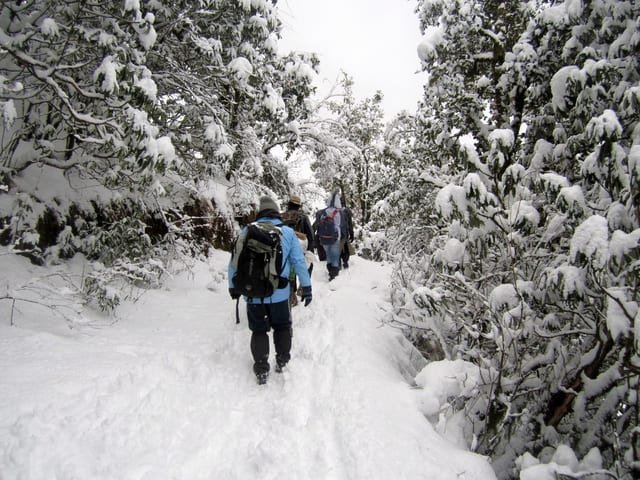
Expeditions



